2021-07-15 - Nº 324
Editorial
Esta é a Newsletter Nº 324 que se apresenta com o mesmo formato que as anteriores. Se gostar da Newsletter partilhe-a!
Todas as Newsletters encontram-se indexadas no link.
Esta Newsletter tem os seguintes tópicos:
Faz hoje anos que nascia, em 1904, o físico russo Pavel A. Cherenkov. Ele descobriu a radiação Cherenkov (1934), uma luz azul ténue emitida por electrões a passar por um meio transparente quando a sua velocidade excede a velocidade da luz nesse meio. Os colegas cientistas soviéticos Igor Y. Tamm e Ilya M. Frank investigaram o fenómeno a partir do qual o contador Cherenkov foi desenvolvido. A utilização extensiva deste detector Cherenkov foi feita mais tarde em aplicações de física nuclear experimental e de partículas. Pelo seu trabalho, o trio partilhou o Prémio Nobel da Física de 1958.
Faz também hoje anos que nascia, em 1915, o físico nuclear norte-americano Albert Ghiorso. Ele co-descobriu 12 novos elementos da tabela periódica. No início da década de 1940, Seaborg mudou-se para Chicago para trabalhar no Projecto Manhattan. Convidou Ghiorso a juntar-se a ele, e durante os quatro anos seguintes Ghiorso desenvolveu instrumentos sensíveis para detectar a radiação associada à decadência nuclear, incluindo a fissão espontânea. Um dos instrumentos inovadores de Ghiorso foi um analisador de altura de pulso de 48 canais, o que lhe permitiu identificar a energia, e portanto a fonte, da radiação. Durante este tempo descobriram dois novos elementos (95, americium e 96, curium), embora a publicação tenha sido retida até depois da guerra. Após a guerra, Seaborg e Ghiorso regressaram a Berkeley, onde eles e colegas utilizaram o ciclotrão Crocker de 60" para produzir elementos com o número atómico aumentado bombardeando alvos exóticos com iões de hélio. Em experiências durante 1949-1950, produziram e identificaram elementos 97 (berkelium) e 98 (californium). Em 1953, numa colaboração com o Laboratório Argonne, Ghiorso e colaboradores procuraram e encontraram elementos 99 (einsteinium) e 100 (fermium), identificados pela sua radiação característica na poeira recolhida por aviões desde a primeira explosão termonuclear (o teste Mike). Em 1955, o grupo utilizou o ciclotrão para produzir 17 átomos do elemento 101 (mendelevium), o primeiro elemento novo a ser descoberto átomo-por-atomo. A técnica de recuo inventada por Ghiorso foi crucial para a obtenção de um sinal identificável de átomos individuais do novo elemento. Em meados dos anos 50, tornou-se claro que para prolongar ainda mais a tabela periódica, seria necessário um novo acelerador, e foi construído o Berkeley Heavy Ion Linear Accelerator (HILAC), com Ghiorso no comando. Esta máquina foi utilizada na descoberta dos elementos 102-106 (102, nobelium; 103, lawrencium; 104, rutherfordium; 105, dubnium e 106, seaborgium), cada um produzido e identificado com base em apenas alguns átomos. A descoberta de cada elemento sucessivo foi possível graças ao desenvolvimento de técnicas inovadoras de manipulação robótica de alvos, química rápida, detectores de radiação eficientes, e processamento informático de dados. A actualização de 1972 do HILAC para o superHILAC forneceu feixes de iões de maior intensidade, o que foi crucial para produzir átomos novos suficientes para permitir a detecção do elemento 106.
Faz igualmente hoje anos que nascia, em 1918, o físico canadiano Bertram Brockhouse. Ele desenvolveu técnicas de difracção de neutrões utilizadas para o estudo da estrutura e propriedades da matéria para a qual partilhou o Prémio Nobel da Física em 1994 (com o físico americano Clifford G. Shull). Ao conceber instrumentos para medir a energia dos neutrões dispersos a partir de um material sólido, Brockhouse forneceu uma visão da sua estrutura atómica. Tornou possíveis avanços na tecnologia dos semicondutores. O seu Espectrómetro de Neutrões de Triplo Eixo é agora amplamente utilizado não só para investigar estruturas atómicas, mas também moléculas de vírus e ADN.
Faz também hoje anos que nascia, em 1921, o bioquímico norte-americano Robert Bruce Merrifield. Ele recebeu o Prémio Nobel da Química de 1984 pelo seu desenvolvimento do método de síntese de peptídeos de fase sólida para a construção de grandes moléculas orgânicas sobre uma matriz sólida. Primeiro anexou um aminoácido a pequenas esferas de polímero plástico, depois adicionou outros aminoácidos, um após o outro, até se construir uma cadeia de polipeptídeos. A cadeia foi então libertada do polímero. As cadeias de aminoácidos podem assim ser construídas em qualquer ordem pré-determinada para sintetizar uma grande variedade de proteínas, hormonas, e outras moléculas orgânicas. O trabalho de Merrifield abrangeu o desenvolvimento de resinas, a protecção de grupos e estratégias químicas, e a engenharia que trouxe a automatização à química peptídea.
Faz igualmente hoje anos que nascia, em 1922, o físico norte-americano Leon M. Lederman. Ele partilhou (com Melvin Schwartz e Jack Steinberger) o Prémio Nobel da Física de 1988 pela sua investigação conjunta e descoberta (1960-62) de uma nova partícula subatómica, o neutrino muon. Neutrinos são partículas subatómicas sem massa detectável e sem carga eléctrica, que se deslocam à velocidade da luz. A descoberta do neutrino muon, foi seguida de descobertas por outros cientistas de uma série de diferentes "famílias" de partículas subatómicas. Juntas, formam agora um modelo padrão, um esquema que tem sido utilizado para classificar todas as partículas elementares conhecidas.
Faz também hoje anos que nascia, em 1930 o matemático americano Stephen Smale. Ele recebeu a Medalha Fields em 1966 pelo seu trabalho em topologia e sistemas dinâmicos. Um dos seus estudos (1961) foi sobre a conjectura generalizada de Poincaré, um famoso problema do século XX, que afirma que um colector tridimensional fechado simplesmente ligado é uma esfera tridimensional. Smale provou uma conjectura de Poincaré de dimensão superior para um colector n-dimensional onde n é pelo menos 5. Noutro trabalho, relacionado com estranhos atractores, um dos primeiros fractais a ser estudado conhecido, descobriu estranhos atractores que levam a sistemas dinâmicos caóticos. (Um atractor na mecânica clássica é uma forma geométrica de descrever o comportamento de um sistema dinâmico). O seu trabalho recente tem sido sobre a informática teórica.
Por fim, faz hoje anos que nascia, em 1943, a astrónomo britânica Jocelyn Bell Burnell. Ela descobriu os primeiros quatro pulsares. Era uma estudante graduada da Universidade de Cambridge, com 24 anos, à procura de quasares em 1967, quando reparou num sinal de rádio estelar invulgar - uma série rápida de pulsos que se repete a cada 1.337 segundos. Este farol interestelar não foi feito pelo homem, por isso foi apelidado de diversão como LGM, para "Little Green Man". Nos meses seguintes, Bell encontrou mais três fontes de impulsos de rádio através de uma análise cuidadosa de centenas páginas anotadas a caneta. Estas representavam uma nova classe de objectos celestes - pulsares - que os astrónomos acabaram por associar à matéria superdensa na fase final da evolução das estrelas maciças. Até à data, foram identificados mais algumas centenas de pulsares.
Em 1954, o Boeing 707 fazia o seu primeiro voo. Na altura conhecido como Boeing 376-80 o avião a jacto tornar-se-ia um dos mais populares de todos os tempos. Hoje em dia versões modificadas deste avião ainda voam como o KC-135 tanker e o E-3 AWACS.
Em 1965, depois de ter chegado a Marte no dia anterior, a sonda Mariner 4 envia para a Terra as primeiras 22 fotografias de Marte. Todas elas apresentam Marte como um vasto e estéril deserto de crateras e areia cor de ferrugem, afastando as suspeitas do século XIX de que uma civilização avançada poderia existir no planeta.
Faz hoje quinze anos que uma empresa chamada Odeo lançava oficialmente uma aplicação chamada Twttr. Nem o nome da empresa nem o nome da aplicação ficaram para a história. Hoje em dia a empresa tem o nome actualmente conhecido da aplicação e chama-se Twitter. Esta era apenas um "side-project" da empresa.
Nesta semana que passou a Virgin Galactic anunciou que a Unidade VSS alcançou com sucesso o espaço, completando o quarto voo espacial da Companhia movido a foguetes. O voo foi o 22º voo de teste do VSS Unity e o primeiro voo de teste com uma tripulação completa na cabine, incluindo o fundador da Companhia, Sir Richard Branson. A tripulação cumpriu uma série de objectivos de teste relacionados com a experiência da cabine e do cliente, incluindo a avaliação da cabine do cliente comercial, as vistas da Terra a partir do espaço, as condições para a realização de investigação e a eficácia do programa de treino de cinco dias de pré-voo no Spaceport America. A Unidade VSS atingiu uma velocidade de Mach 3 após ter sido libertada da nave mãe, VMS Eve. O veículo alcançou o espaço, a uma altitude de cerca de 86 quilómetros, antes de deslizar suavemente para uma pista de aterragem no Spaceport America.
Na Newsletter desta semana apresentamos diversas noticias, artigos científicos, projetos de maker assim como alguns videos interessantes.
 João Alves ([email protected])
João Alves ([email protected])
O conteúdo da Newsletter encontra-se sob a licença  Creative Commons Attribution-NonCommercial-ShareAlike 4.0 International License.
Creative Commons Attribution-NonCommercial-ShareAlike 4.0 International License.
Novidades da Semana

Virgin Galactic Successfully Completes First Fully Crewed Spaceflight
"Virgin Galactic today announced that VSS Unity successfully reached space, completing the Company’s fourth rocket-powered spaceflight. Today’s flight was the 22nd test flight of VSS Unity and the first test flight with a full crew in the cabin, including the Company’s founder, Sir Richard Branson. The crew fulfilled a number of test objectives related to the cabin and customer experience, including evaluating the commercial customer cabin, the views of Earth from space, the conditions for conducting research and the effectiveness of the five-day pre-flight training program at Spaceport America. Michael Colglazier, Chief Executive Officer of Virgin Galactic, said: “Today is a landmark achievement for the Company and a historic moment for the new commercial space industry. With each successful mission we are paving the way for the next generation of astronauts. I want to thank our talented team, including our pilots and crew, whose dedication and commitment made today possible." [...]
Outras Notícias
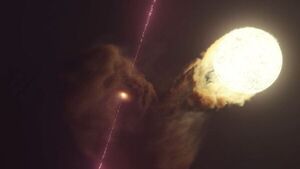
Seeing Some Cosmic X-Ray Emitters Might Be a Matter of Perspective
"Known as ultraluminous X-ray sources, the emitters are easy to spot when viewed straight on, but they might be hidden from view if they point even slightly away from Earth. It’s hard to miss a flashlight beam pointed straight at you. But that beam viewed from the side appears significantly dimmer. The same holds true for some cosmic objects: Like a flashlight, they radiate primarily in one direction, and they look dramatically different depending on whether the beam points away from Earth (and nearby space telescopes) or straight at it. New data from NASA’s NuSTAR space observatory indicates that this phenomenon holds true for some of the most prominent X-ray emitters in the local universe: ultraluminous X-ray sources, or ULXs. Most cosmic objects, including stars, radiate little X-ray light, particularly in the high-energy range seen by NuSTAR." [...]
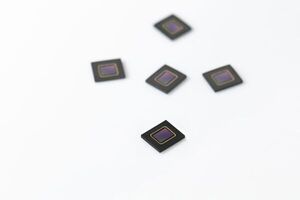
Samsung Introduces Its First ISOCELL Image Sensor Tailored for Automotive Applications
"Samsung Electronics, a world leader in advanced semiconductor technology, today introduced ISOCELL Auto 4AC, an automotive image sensor that offers advanced 120-decibel (dB) high dynamic range (HDR) and LED flicker mitigation (LFM) especially for surround-view monitors (SVM) or rear-view cameras (RVC) in high-definition resolution (1280 x 960). The new sensor is Samsung’s first imaging solution optimized for automotive applications. “The new ISOCELL Auto 4AC combines Samsung’s innovative and market-proven image sensor technologies with a unique CornerPixel™ solution for advanced HDR and LFM capabilities, offering exceptional viewing experiences regardless of lighting conditions,” said Duckhyun Chang, executive vice president of sensor business at Samsung Electronics. “Starting with the ISOCELL Auto 4AC, we plan to expand our automotive sensor lineup to areas such as camera monitor systems (CMS), autonomous driving and in-cabin monitoring.” Various lighting situations on the road may pose obstacles to the driver. Quick transitions from a low-lit environment to a brighter one, such as exiting a tunnel, may require a few seconds for the driver’s eyes to adjust. Also, flickering from LED headlamps or road signage, such as street lamps and traffic lights, could become increasingly noticeable on the automotive system’s camera screen." [...]
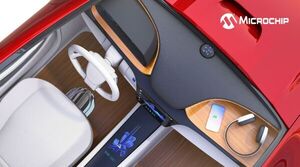
New Qi 1.3 Wireless Charging Reference Design Unveiled to Accelerate Development of Automotive and Consumer Qi Transmitter
"Microchip’s Qi 1.3 reference design is compliant with the recently released Qi 1.3 specification and includes everything needed to quickly develop a Qi 1.3 certified transmitter The Wireless Power Consortium (WPC) has recently released the Qi 1.3 specification that requires authentication for improved safety when transmitting up to 15W of power between a transmitter and a receiver. To meet the requirements of the specification, Microchip Technology Inc. (Nasdaq: MCHP) announced today a new Qi® 1.3 wireless charging reference design providing developers of wireless charging systems for automotive and consumer applications with the necessary tools and support for the seamless integration and certification of new-generation product designs. For wireless charging system developers launching certified Qi 1.3 transmitters under tight timelines, Microchip’s three-coil Qi 1.3 reference design provides a head start for product development. The reference design fully integrates secure storage subsystem software with the wireless power microcontroller (MCU) and is a flexible solution, enabling custom topologies and foreign object detection (FOD) implementation. As a regular member in the Wireless Power Consortium (WPC), which sets global standards for wireless charging of mobile devices, Microchip provided expertise during development of the recently released Qi 1.3 specification. Qi 1.3 is a significant update from Qi 1.2.4 and mandates hardware-based authentication between transmitter and receiving devices for power transfer above 5W." [...]

New Renesas Solution For Automotive Cameras Enables High-Definition Video Using Low-Cost Cables and Connectors
"Automotive HD Link (AHL) Complements Other Renesas Products in Auto Safety Systems; Includes Unique Control Channel That Initializes, Programs and Monitors the Camera Function Renesas Electronics Corporation (TSE:6723), a premier supplier of advanced semiconductor solutions, today introduced its new Automotive HD Link (AHL) technology that enables automotive manufacturers to deliver high-definition video over low-cost cables and connectors that currently support standard-definition video. HD video is increasingly important in car safety systems for object recognition functionality. Renesas is a leader in the Advanced Driver Assist Systems (ADAS) market, and AHL can be paired with other Renesas products, such as the R-Car Automotive SoCs, RH850 MCUs, automotive PMICs, and analog components to cost-effectively implement numerous safety features in virtually any vehicle. The new RAA279971 AHL encoder and RAA279972 decoder use a modulated analog signal to transmit the video, enabling transmission rates 10 times less than required to transmit HD signals digitally. The lower transmission rate means that traditional twisted pair cables and standard connectors can be used, as can existing analog video cables and connectors. On the other hand, digital links such as SerDes require heavily shielded cables and high-end connectors that cost significantly more than those for AHL, may require replacement after 5-7 years and are difficult to route due to bending radius limitations." [...]

New MCU portfolio redefines microcontroller performance, enabling 10 times higher processing capability than existing devices
"Engineers can combine processor-level computing with MCU design simplicity for real-time control, analytics and networking applications with TI Sitara™ AM2x MCUs Texas Instruments (TI) (Nasdaq: TXN) today introduced a new high-performance microcontroller (MCU) portfolio that advances real-time control, networking and analytics applications at the edge. With new Sitara AM2x MCUs, engineers can achieve 10 times the computing capability of traditional, flash-based MCUs. This high-performance portfolio closes the growing gap between today’s MCUs and processors, enabling designers to push the limits in applications such as factory automation, robotics, automotive systems and sustainable energy management. For more information, see ti.com/AM2x-pr. "Demands for industrial automation, next-generation vehicles, intelligent analytics, and higher levels of connectivity are all fueling the need for fast, accurate microcontrollers at the edge. Delivering more advanced, power-efficient processing to distributed systems is one of the critical next steps in Industry 4.0," said Chris Morris, senior research analyst at Omdia." [...]

Renesas Launches High-Reliability Radiation-Hardened Plastic Portfolio For Satellites in Medium and Geosynchronous Earth Orbits
"New Lineup Provides High Reliability and Reduced SWAP; Co-Packaged Solution for Space Delivers World-Class GaN FET Driver Performance Renesas Electronics Corporation (TSE:6723), a premier supplier of advanced semiconductor solutions, today launched a new line of plastic-packaged radiation-hardened (rad-hard) devices for satellite power management systems. The four new devices include the ISL71001SLHM/SEHM point of load (POL) buck regulator, ISL71610SLHM and ISL71710SLHM digital isolators, and the ISL73033SLHM 100V GaN FET and integrated low-side driver. Combining rad-hard assurance levels with the board area savings and cost advantages of plastic packaging, the new portfolio brings space-grade solutions to missions in medium/geosynchronous Earth orbit (MEO/GEO) with longer lifetime requirements, as well as small satellites (smallsats) and higher density electronics, while reducing size, weight, and power (SWaP) costs. The new ICs also complement the radiation-tolerant plastic-package ICs Renesas introduced in 2017 for smallsats in Low Earth Orbit. Together, Renesas’ plastic IC lineup supports multiple orbit ranges, providing the radiation performance and optimal cost balance required for a variety of satellite subsystems and payloads. “With every new mission, customers want more functionality, which requires larger satellite payloads and has traditionally translated into increased SWaP for the satellite systems,” said Philip Chesley, Vice President, Industrial and Communications Business Division at Renesas." [...]
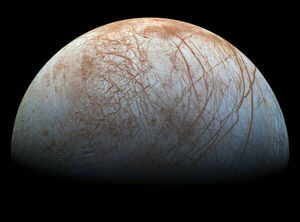
Surface of Jupiter’s Moon Europa Churned by Small Impacts
"Jupiter’s moon Europa and its global ocean may currently have conditions suitable for life. Scientists are studying processes on the icy surface as they prepare to explore. It’s easy to see the impact of space debris on our Moon, where the ancient, battered surface is covered with craters and scars. Jupiter’s icy moon Europa withstands a similar trouncing – along with a punch of super-intense radiation. As the uppermost surface of the icy moon churns, material brought to the surface is zapped by high-energy electron radiation accelerated by Jupiter. NASA-funded scientists are studying the cumulative effects of small impacts on Europa’s surface as they prepare to explore the distant moon with the Europa Clipper mission and study the possibilities for a future lander mission." [...]

NASA’s Mars Helicopter Reveals Intriguing Terrain for Rover Team
"Ingenuity’s ninth flight provided imagery that will help the Perseverance rover team develop its science plan going forward. Images snapped on July 5 by NASA’s Ingenuity Mars Helicopter on its ambitious ninth flight have offered scientists and engineers working with the agency’s Perseverance Mars rover an unprecedented opportunity to scout out the road ahead. Ingenuity provided new insight into where different rock layers begin and end, each layer serving as a time capsule for how conditions in the ancient climate changed at this location. The flight also revealed obstacles the rover may have to drive around as it explores Jezero Crater. During the flight – designed to test the helicopter’s ability to serve as an aerial scout – Ingenuity soared over a dune field nicknamed “Séítah.” Perseverance is making a detour south around those dunes, which would be too risky for the six-wheeled rover to try crossing. The color images from Ingenuity, taken from a height of around 33 feet (10 meters), offer the rover team much greater detail than they get from the orbiter images they typically use for route planning." [...]

40-Year Mystery Solved: Source of Jupiter’s X-Ray Flares Uncovered
"A puzzler about the gas giant’s intense northern and southern lights has been deciphered. Planetary astronomers combined measurements taken by NASA’s Juno spacecraft orbiting Jupiter, with data from ESA’s (the European Space Agency’s) Earth-orbiting XMM-Newton mission, to solve a 40-year-old mystery about the origins of Jupiter’s unusual X-ray auroras. For the first time, they have seen the entire mechanism at work: The electrically charged atoms, or ions, responsible for the X-rays are “surfing” electromagnetic waves in Jupiter’s magnetic field down into the gas giant’s atmosphere. A paper on the study was published on July 9 in the journal Science Advances. Auroras have been detected on seven planets in our solar system. Some of these light shows are visible to the human eye; others generate wavelengths of light we can only see with specialized telescopes." [...]

NASA Solar Sail Asteroid Mission Readies for Launch on Artemis I
"Sailing on sunlight, NEA Scout will capture images of an asteroid for scientific study. NASA’s Near-Earth Asteroid Scout is tucked away safely inside the agency’s powerful Space Launch System (SLS) rocket at NASA’s Kennedy Space Center in Florida. The solar sailing CubeSat is one of several secondary payloads hitching a ride on Artemis I, the first integrated flight of the agency’s SLS and the Orion spacecraft. NEA Scout, a small spacecraft roughly the size of a large shoebox, has been packaged into a dispenser and attached to the adapter ring that connects the SLS rocket and Orion spacecraft. The Artemis I mission will be an uncrewed flight test. It also offers deep space transportation for several CubeSats, enabling opportunities for small spacecraft like NEA Scout to reach the Moon and beyond as part of the Artemis program." [...]
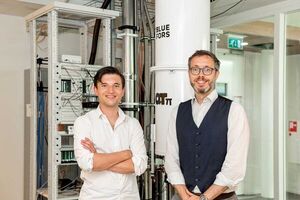
Quantware Launches The World’S First Commercially Available Superconducting Quantum Processors, Accelerating The Advent Of The Quantum Computer
"Today Dutch startup QuantWare has launched the world’s first commercially available superconducting processor for quantum computers (QPU). This is the first time superconducting quantum processors have been available ‘off the shelf’, a development with the potential to significantly accelerate the quantum computing revolution. Quantum technology promises to significantly expand the amount of data computers are able to process, which could have huge implications for fields such as A.I., medicine, business intelligence, and cybersecurity. But the quantum industry is still young and scaling is difficult. Companies building parts for quantum computers need qubits, the microscopic objects that make quantum computing possible, but it is often cost prohibitive for them to produce them themselves. QuantWare’s superconducting QPUs eliminate that barrier and may be instrumental in accelerating the development of the quantum computer market." [...]
Ciência e Tecnologia

Training an AI eye on the Moon
"Machine learning accelerates the search for promising Moon sites for energy and mineral resources. A Moon-scanning method that can automatically classify important lunar features from telescope images could significantly improve the efficiency of selecting sites for exploration. There is more than meets the eye to picking a landing or exploration site on the Moon. The visible area of the lunar surface is larger than Russia and is pockmarked by thousands of craters and crisscrossed by canyon-like rilles. The choice of future landing and exploration sites may come down to the most promising prospective locations for construction, minerals or potential energy resources. However, scanning by eye across such a large area, looking for features perhaps a few hundred meters across, is laborious and often inaccurate, which makes it difficult to pick optimal areas for exploration." [...]
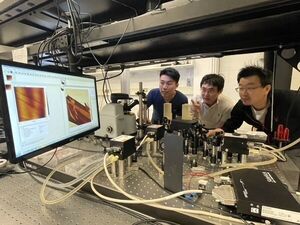
Custom-made MIT tool probes materials at the nanoscale
"A scattering-type scanning nearfield optical microscope offers advantages to researchers across many disciplines. An MIT physicist has built a new instrument of interest to MIT researchers across a wide range of disciplines because it can quickly and relatively inexpensively determine a variety of important characteristics of a material at the nanoscale. It’s capable of not only determining internal properties of a material, such as how that material’s electrical or optical conductivity changes over exquisitely short distances, but also visualizing individual molecules, like proteins. “Modern materials research has greatly benefited from advanced experimental tools,” says Long Ju, an assistant professor in the Department of Physics. Ju is an expert on an emerging instrument that combines nanoscopy — the ability to see things at the nanoscale — with spectroscopy, which probes materials by exploring their interactions with light. The tool, known as a near-field infrared nanoscope and spectroscope (it is also known as a scattering-type scanning nearfield optical microscope, or s-SNOM), is available commercially." [...]

Getting dressed with help from robots
"A human-aware motion planning algorithm addresses the safety gap in collaboration between robots and humans. Basic safety needs in the paleolithic era have largely evolved with the onset of the industrial and cognitive revolutions. We interact a little less with raw materials, and interface a little more with machines. Robots don’t have the same hardwired behavioral awareness and control, so secure collaboration with humans requires methodical planning and coordination. You can likely assume your friend can fill up your morning coffee cup without spilling on you, but for a robot, this seemingly simple task requires careful observation and comprehension of human behavior. Scientists from MIT’s Computer Science and Artificial Intelligence Laboratory (CSAIL) have recently created a new algorithm to help a robot find efficient motion plans to ensure physical safety of its human counterpart." [...]
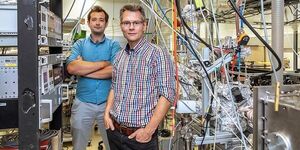
Electrons in quantum liquid gain energy from laser pulses
"The absorption of energy from laser light by free electrons in a liquid has been demonstrated for the first time. Until now, this process was observed only in the gas phase. The findings, led by Graz University of Technology, open new doors for ultra-fast electron microscopy. The investigation and development of materials crucially depends on the ability to observe smallest objects at fastest time scales. The necessary spatial resolution for investigations in the (sub-)atomic range can be achieved with electron microscopy. For the most rapid processes, however, proceeding within a few femtoseconds (quadrillionths of a second), the time resolution of conventional electron microscopes is insufficient." [...]

Galactic gamma ray bursts predicted last year show up on schedule
"Magnetars are bizarre objects — massive, spinning neutron stars with magnetic fields among the most powerful known, capable of shooting off brief bursts of radio waves so bright they’re visible across the universe. A team of astrophysicists has now found another peculiarity of magnetars: They can emit bursts of low energy gamma rays in a pattern never before seen in any other astronomical object. It’s unclear why this should be, but magnetars themselves are poorly understood, with dozens of theories about how they produce radio and gamma ray bursts. The recognition of this unusual pattern of gamma ray activity could help theorists figure out the mechanisms involved. “Magnetars, which are connected with fast radio bursts and soft gamma repeaters, have something periodic going on, on top of randomness,” said astrophysicist Bruce Grossan, an astrophysicist at the University of California, Berkeley’s Space Sciences Laboratory (SSL). “This is another mystery on top of the mystery of how the bursts are produced.” The researchers — Grossan and theoretical physicist and cosmologist Eric Linder from SSL and the Berkeley Center for Cosmological Physics and postdoctoral fellow Mikhail Denissenya from Nazarbayev University in Kazakhstan — discovered the pattern last year in bursts from a soft gamma repeater, SGR1935+2154, that is a magnetar, a prolific source of soft or lower energy gamma ray bursts and the only known source of fast radio bursts within our Milky Way galaxy." [...]

5D imaging of ultrafast phenomena
"Spectral-volumetric compressed ultrafast photography simultaneously captures 5D information in a single snapshot Information-rich optical imaging can provide multidimensional information to enable observation and analysis of a detected target, contributing insights into mysterious and unknown worlds. With its ability to capture dynamic scenes on picosecond—and even femtosecond—timescales, ultrafast multidimensional optical imaging has important applications in the detection of the ultrafast phenomena in physics, chemistry, and biology. While pump-probe-based ultrafast imaging can acquire high-resolution multidimensional information, it cannot adequately capture unstable or irreversible transient scenes. Fortunately, compressed ultrafast photography (CUP), based on compressed sensing and streak imaging, surpasses traditional pump-probe-based ultrafast imaging. CUP has attracted broad attention due to its high temporal resolution, high data-throughput, and single-shot acquisition. It has been successfully applied in the studies of various ultrafast phenomena, such as capturing ultrafast photons, observing optical Mach cone, and detecting optical chaotic dynamics." [...]

TSUBAME supercomputer predicts cell-membrane permeability of cyclic peptides
"Scientists at Tokyo Institute of Technology have developed a computational method based on large-scale molecular dynamics simulations to predict the cell-membrane permeability of cyclic peptides using a supercomputer. Their protocol has exhibited promising accuracy and may become a useful tool for the design and discovery of cyclic peptide drugs, which could help us reach new therapeutic targets inside cells beyond the capabilities of conventional small-molecule drugs or antibody-based drugs. Cyclic peptide drugs have attracted the attention of major pharmaceutical companies around the world as promising alternatives to conventional small molecule-based drugs. Through proper design, cyclic peptides can be tailored to reach specific targets inside cells, such as protein–protein interactions, which are beyond the scope of small molecules. Unfortunately, it has proven notoriously difficult to design cyclic peptides with high cell-membrane permeability—that is, cyclic peptides that can easily diffuse through the lipid bilayer that delimits the inside and outside of a cell. In an effort to resolve this bottleneck, scientists at the Middle Molecule IT-based Drug Discovery Laboratory (MIDL) have been working on a computational method for predicting cell-membrane permeability." [...]
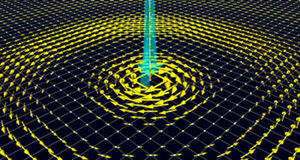
Two-dimensional materials and interfaces can convert spin current into a vortex of charge current
"Low-power information processing could be possible using a new method for converting between spin and charge currents Energy-efficient spintronic devices are closer to being realized thanks to a new mechanism predicted by RIKEN physicists for converting between electrical current vortices and a spin current1. In addition to its negative electrical charge, an electron has a property known as spin, which can take one of two values: up or down. Just as an electron’s charge is harnessed for information processing in electronics, so the flow of spin could be used in the emerging field of spintronics. Spintronics has the advantage of being more energy efficient than conventional electronics since, unlike an electrical current, a spin current does not generate Joule heat. An efficient mechanism for converting an electronic current into a spin current and vice versa is crucial for developing spintronic devices. Now, by using numerical simulations, Sadamichi Maekawa and Seiji Yunoki, both from the RIKEN Center for Emergent Matter Science, together with their co-workers have demonstrated the conversion of a spin current into a rotating vortex of charge current (Fig." [...]

New evidence of an anomalous phase of matter brings energy-efficient technologies closer
"Researchers have found evidence for an anomalous phase of matter that was predicted to exist in the 1960s. Harnessing its properties could pave the way to new technologies able to share information without energy losses. These results are reported in the journal Science Advances. While investigating a quantum material, the researchers from the University of Cambridge who led the study observed the presence of unexpectedly fast waves of energy rippling through the material when they exposed it to short and intense laser pulses. They were able to make these observations by using a microscopic speed camera that can track small and very fast movement on a scale that is challenging with many other techniques. This technique probes the material with two light pulses: the first one disturbs it and creates waves – or oscillations - propagating outward in concentric circles, in the same way as dropping a rock into a pond; the second light pulse takes a snapshot of these waves at various times." [...]

New mechanism of superconductivity discovered in graphene
"Placing a 2D Bose-Einstein condensate in the vicinity of a graphene layer confers superconductivity to the material Superconductivity is a physical phenomenon where the electrical resistance of a material drops to zero under a certain critical temperature. Bardeen-Cooper-Schrieffer (BCS) theory is a well-established explanation that describes superconductivity in most materials. It states that Cooper pairs of electrons are formed in the lattice under sufficiently low temperature and that BCS superconductivity arises from their condensation. While graphene itself is an excellent conductor of electricity, it does not exhibit BCS superconductivity due to the suppression of electron-phonon interactions. This is also the reason that most ‘good’ conductors such as gold and copper are ‘bad’ superconductors. Researchers at the Center for Theoretical Physics of Complex Systems (PCS), within the Institute for Basic Science (IBS, South Korea) have reported on a novel alternative mechanism to achieve superconductivity in graphene." [...]

Nanosphere at the quantum limit
"Researchers at ETH Zurich have trapped a tiny sphere measuring a hundred nanometres using laser light and slowed down its motion to the lowest quantum mechanical state. Based on this, one can study quantum effects in macroscopic objects and build extremely sensitive sensors. Why can atoms or elementary particles behave like waves according to quantum physics, which allows them to be in several places at the same time? And why does everything we see around us obviously obey the laws of classical physics, where that is impossible? To answer those questions, in recent years researchers have coaxed larger and larger objects into behaving quantum mechanically. One consequence of this is that, when passing through a double slit, they form an interference pattern that is characteristic of waves." [...]

UBCO researchers light the way to cleaner water
"Fluorescence lighting helps detect impurities in water Shining a beam of light into potentially contaminated water samples may hold the key to real-time detection of hydrocarbons and pesticides in water. UBC Okanagan researchers are testing the use of fluorescence to monitor water quality. The results, they say, show great promise. When a beam of light is shone into the water, it excites the electrons in molecules of certain compounds and causes them to emit light. The characteristics of the emitted light are like a fingerprint and can be used to identify certain contaminants, explains Nicolas Peleato, an assistant professor at UBCO’s School of Engineering. “The challenge with using this fluorescence approach is that they are typically source-specific; meaning we have to calibrate for a particular water source and anticipate what specific contaminants we want to look for,” says Peleato." [...]
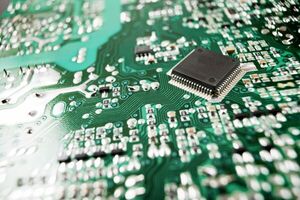
FAU research group develops smart microparticle that identifies defective parts in electrical appliances
"Repairing complex electrical appliances is time consuming and rarely cost-effective. The working group led by Prof. Dr. Karl Mandel, Professorship of Inorganic Chemistry at FAU, has now developed a smart microparticle that enables defective components in these appliances to be identified more quickly and easily by using light signals. In the long-term, this could make repairs easier and extend the operating life of devices. The results have been published in the journal ‘Advanced Functional Materials’. To identify defective components in a device, particles known as supraparticles are applied to the individual parts. These particles measure between one and ten micrometres and under black light they provide information about the component’s identity and temperature history (the temperatures the specific component was recently subjected to) by emitting blue, green and red light." [...]
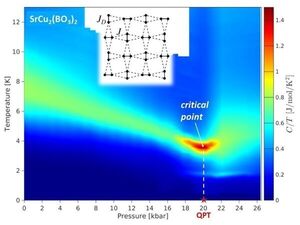
Quantum phase transition discovered in a quasi-2D system consisting purely of spins
"Pure quantum systems can undergo phase transitions analogous to the classical phase transition between the liquid and gaseous states of water. At the quantum level, however, the particle spins in states that emerge from phase transitions display collective entangled behavior. This unexpected observation offers a new avenue for the production of materials with topological properties that are useful in spintronics applications and quantum computing. The discovery was made by an international collaboration led by Julio Larrea, a professor at the University of São Paulo’s Physics Institute (IF-USP) in Brazil. Larrea is first author of an article on the study published in Nature. The research was supported by FAPESP." [...]
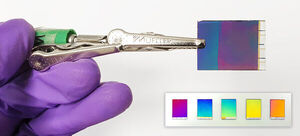
New electronic paper displays brilliant colours
"Imagine sitting out in the sun, reading a digital screen as thin as paper, but seeing the same image quality as if you were indoors. Thanks to research from Chalmers University of Technology, Sweden, it could soon be a reality. A new type of reflective screen – sometimes described as ‘electronic paper’ – offers optimal colour display, while using ambient light to keep energy consumption to a minimum. Traditional digital screens use a backlight to illuminate the text or images displayed upon them. This is fine indoors, but we’ve all experienced the difficulties of viewing such screens in bright sunshine. Reflective screens, however, attempt to use the ambient light, mimicking the way our eyes respond to natural paper. “For reflective screens to compete with the energy-intensive digital screens that we use today, images and colours must be reproduced with the same high quality." [...]
Projetos Maker
Diversos Projetos interessantes.
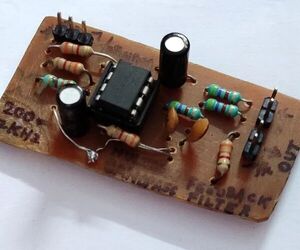
Multiple Feedback Bandpass Filter for Woofer
"Band Pass filter is one which can pass only a specified band of frequencies. For example a band pass filter for woofers have the lower cutoff frequency as 200Hz and upper cutoff frequency as 2KHz, that is the mid range audio frequencies. I have made this bandpass filter which is suitable for woofers, that is the Mid Range speakers. This bandpass circuit is an active filter circuit. This circuit is made using the Multiple Feedback technique with OPAMP. A single OPAMP section can make up the circuit for bandpass action." [...]
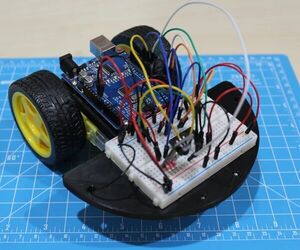
Remote Control Arduino Car
"A great introductory project for those diving into the IoT and Arduino platform. Working with motors and an IR sensor helps newbies understand various components and sensors compatible with the Arduino. Using the remote control, you will be able to control the robot's movement allowing the robot to move in straight lines or turn based on human input. Created by Divyank Shah, an upcoming Computer Science major at the University of California, Riverside. Divyank Shah is an ambitious individual looking to study further in computer science with a deep interest in microcontroller and microprocessing technologies. Supplies - Arduino Uno - 400 Point Solderless Breadboard - Caster Wheel (Universal Wheel) - 2 x TT Motors (1:48 Gearbox) - 2 x TT Motor Wheels with Slotted Inserts - 2 x 2 AA Cell Battery Holder - 4 x AA 1.5 V Batteries - L293D Motor Driver - IR Sensor with Remote - Assortment of Jumper Cables - Double Sided 3M Tape - Soldering Iron with Solder - Heat Shrink / Electrical Tape - Screw Driver - 3D Printer (Ender 3 V2 used)" [...]

DIY Arduino Wireless Motion Alarm System
"Hello everybody hope you're doing well, in this instructable I'm going to show you how to make a wireless motion alarm system, this device consists of a transmitter and a receiver. So essentially it is a pretty simple and basic wireless motion alarm system with light indication. Besides being fairly useful it is also a simple project that is great for folks that are just starting to tinker with electronics and microcontrollers because in its concept it is pretty basic and is made from parts that are not hard to find. I will also share with you some tips and tricks on how to do some troubleshooting if you decide to give this project a go yourself. Supplies - Arduino nano boards 2x - 433 MHz transmitter and receiver module - PIR sensor - Switches 2x - LED - 100-ohm resistor - Some kind of a box (one for a receiver, and one for a transmitter) - 9v battery connector 2x - Tools Soldering iron as well as some solder, utility knife, pliers, wire cutters, drill. " [...]
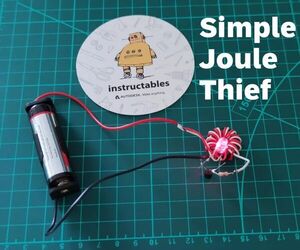
Simple Joule Thief
"Wikipedia says : A joule thief is a minimalist self-oscillating voltage booster that is small, low-cost, and easy to build, typically used for driving small loads. This circuit is also known by other names such as blocking oscillator, joule ringer, vampire torch. It can use nearly all of the energy in a single-cell electric battery, even far below the voltage where other circuits consider the battery fully discharged (or "dead"); hence the name, which suggests the notion that the circuit is stealing energy or "joules" from the source the term is a pun on "jewel thief". The circuit is a variant of the blocking oscillator that forms an unregulated voltage boost converter. The output voltage is increased at the expense of higher current draw on the input, but the integrated (average) current of the output is lowered and brightness of a luminescence decreased. I say it's a fun little weekend project that can be done with very few parts (even salvaged) and discharged/dead batteries." [...]
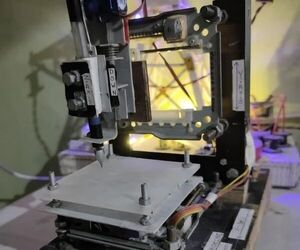
MINI CNC Ink Plotter Machine
"In this project I'm showing you step by step how to build a low cost Arduino based mini CNC ink plotter machine using a scrap DVD player's stepper motors , Arduino NANO, and also I will show you how to make a circuit/driver for stepper motors. The maximum printing area of this CNC machine is (40*40mm). You can use this machine for drawing labels, symbols etc., this CNC machine is requires only 5V, 1A of power for the working. Supplies - Arduino Nano/UNO - Two scrap DVD players - Servo Motor - L293D IC *2 - Screw terminals * 5 - Female/male header pins - Zero PCB board - 90 degree aluminum angle - Plywood sheet - PVC or acrylic sheet - Nut bolts - 5v,1amp adapter" [...]
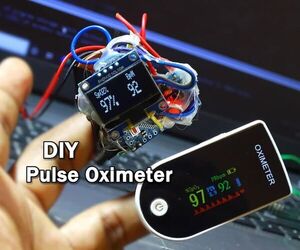
DIY Pulse Oximeter
"Hello all, I Hope you all are safe. I'm here with another project which you can build with very few components. In this writeup, I'm going to tell you, how you can make a Pulse Oximeter by using Arduino and some very basic electronic components, in this pandemic situation of Covid19 most of us probably familiar with oximeter which we use to measure oxygen saturation in blood and the pulse rate. So let's see.. How An Oximeter works? Basically Oximeter calculates the percentage oxygen saturation in the blood on basis of amount of different light absorb in it. Oximeter has One photodiode and two LEDs one is Red LED & another one is InfraRed LED, both LEDs are switched one by one on a certain frequency." [...]

Mini Regulated Power Supply Unit
"I've always been attracted by compact instruments, and I love to buy electronics kits and build small and pretty devices.Years ago I bought a regulated power supply unit (PSU), which has the interesting feature to vary current intensity other than voltage.Voltage (Volt) is the "pressure" of the electric current, and intensity (Ampere) is the "flow rate" of the current. You have a big power (Watt) when you have a high flow which push hard ;-) As first thing I tested my device, and I started to imagine the best way to build something around it. As you can see I connected it to the battery pack I lately refurbished with ten 18650 cells. Since that Li-Ion power bank is quite powerful now, I wished to take the best advantage from it. I also thought to incorporate the device inside the battery pack, but space was not enough. This way the regulated PSU can be powered by any battery or wall plug power supply." [...]
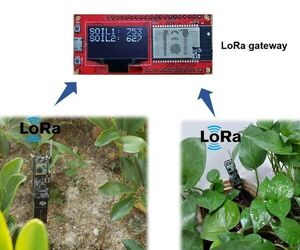
ESP32 As LoRa Gateway With Arduino
"In the past, I had done a project that monitored the soil moisture with LoRa and used the ESP32-LoRa board to be a LoRa gateway by programming with Micropython. It has a little unfriendly for Arduino users. You can check the previous project via the video. Now I wanted to program the ESP32 with Arduino, and assemble it with the LoRa expansion board as the LoRa gateway to receive the soil moisture reading transmitted by the soil moisture sensor. " [...]

Investigating Non-Linear Resonance in Chua's Circuit
"What is non-linear resonance? Resonance is defined as a physical phenomenon where the response of a dynamical system reaches a maximum amplitude as a result of an applied periodic force. Nevertheless, what are dynamical systems and periodic forces? Brief explanations will be provided in the following lines to lay out a conceptual intuition before diving into the experiments. **** Note that readers with a background in physics or mathematics can skip the first part of the introduction and dive right into the project objectives and experiments. 1.Dynamical system Nouns are used to represent everyday objects." [...]

Joystick Controlled 2 x RC Servo motors – Arduino Compatible
"This project enables easy control of 2 RC servo motors using a thumb joystick. This is an Arduino compatible project and it consists of a thumb joystick, ATMEGA328 microcontroller, filter capacitor on dc supply, and other components. The thumb joystick has 2 axes, X and Y. The joystick consists of 2 x 10K potentiometers. These potentiometers provide analog voltage output as per the movement of each axis. The microcontroller reads this analog voltage and converts it to RC PWM pulse." [...]

Desk Calculator with CircuitPython
"Consider the humble calculator. Now just an app that you always have with you on your telephone, an electronic calculator used to be a technological marvel. In this project, you'll build your own calculator with an Adafruit Feather RP2040, 128x64 OLED display, and 20 keys. Optional 3D printed parts like an enclosure and even the keycaps themselves make for a sharp presentation. Make it your own by customizing the code, or use the hardware for your own MacroPad-inspired project. Custom Printed Circuit Board This project needs a custom PCB." [...]

New Automated Driveway Gates
"This tutorial is for making DIY automated driveway gates for relatively cheap using Arduino, ESP8266, Raspberry Pi, and Blynk! Problem: My driveway is a public turn-around. Solution: gates. So we bought some gates, but getting out of the car to open two gates twice a day is really monotonous. I looked at automated gate kits, but they range from $400 - $900; in short, way too much. I decided to make my own, seeing that it would be more cost effective and much more fun!" [...]
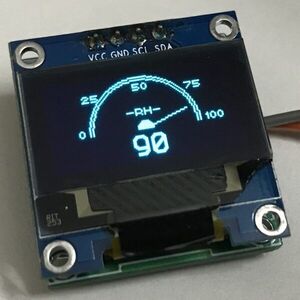
Humidity Meter Using OLED Display – Arduino Compatible
"This is an easy to build, very compact, and low profile Arduino compatible platform to build a humidity meter/Gauge using a 0.96Inch OLED display. The project consists of Atmega328 microcontroller, 0.96Inch OLED display, 3.3V regulator, and HIH5030 analog humidity sensor from Honeywell. The HIH5030 sensor provides an analog voltage output, the analog voltage is near linear voltage output vs %RH, the sensor output is connected to A0 (Arduino-ADC pin 0) of the ATmega328 microcontroller. The sensor output is 0.25V to 2.5V vs 0 to 100% RH. Connector CN2 is provided for boot-loader flashing and Arduino programming. Use Pin 4 GND and Pin5 VCC to power the project." [...]

Reverse Engineering the M6 Smart Fitness Bracelet
"Following a year and a half of sitting inside the house, I set out to improve my wellbeing by getting a new fitness tracker. It worked out better than I expected - hacking on it kept me busy for a couple of months - at the small price of making me sitting inside the house even harder. Before starting, I stated my goals as follows. I wanted to: 1. Understand its hardware 2. Figure out how to talk to it 3." [...]
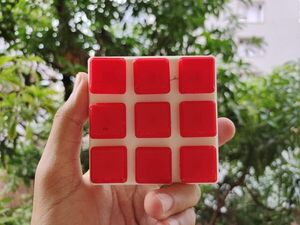
Pico KeyPad
"A shortcut keypad for your PC work. Pico KeyPad is a must-have shortcut keyboard for your PC work. This keypad consists of 9 keys (you can add more no. of keys), the size of this 9x9 keypad is small and can be easily carried out. All this 9 keys can be programed for any shortcut. You can use it during programming / Coding or during editing and more, all the software shortcuts are compatible with this keypad." [...]

3D-Printable Hotswap Keyboard PCB Generator
"This is an OpenSCAD script that can be used to generate 3D-printable hotswap "PCBs" and plates for prototyping new keyboard layouts. I originally wrote this to help me prototype a split ergo layout without needing to solder/desolder all the switches every time. If you're only going to be building the keyboard once, this is probably a lot more work than just handwiring, but it might be useful if you're iterating on a design and want to reuse your switches. Currently supports MX and Kailh Choc v1 switches. If someone wants to send me low-profile Cherry switches or v2 Chocs I can add those as well. " [...]

Solar Powered Rotating Strawberry Tower
"Here is a scenario: - You live in an apartment and you have a small balcony, or you live in a house with no garden. - You want to grow a lot of strawberries (or other veggies) on a very small place. - You want a strawberry tower, but the sun will shine it only from one side and the rear half of the tower will grow badly. - You are sad about that In this Instructable you will find an answer to your problems :) A solar rotating strawberry tower! Aka. Environmentally Friendly Vegan Kebab :) It uses a small solar cell and a small DC motor to rotate the tower very slowly - 0.6 revolutions per minute to be precise." [...]

Busted! Create an ML-Powered Speed Trap
"Build a "speed trap" that uses ML to identify vehicles, a radar sensor to measure speed, and a cellular module to report data to the cloud. For my family, one of the positive side effects of living through a global pandemic was coming up with activities to fill the void normally occupied by soccer practices and Girl Scout meetings. Yep, we actually had to interact with each other. So we focused on walking. A lot. We made up arbitrary journeys like dropping the car off for maintenance and trekking home across town (a journey made longer with whining kids through neighborhoods I had never visited before)." [...]
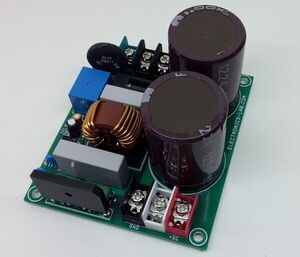
High Voltage DC Power Supply for Intelligent Power Modules
"Although this power supply design is specific to the Intelligent Power Modules (IPM), the concepts and circuit design may be used for any power supply that requires high voltage output up to 400V DC and 6 A. It is an unregulated power supply, DC output is dependent on AC input. The circuitry includes a passive EMI filter consisting of elements C5, C6, C7, C8, C9, C10, T1, and a BR1 25 A/600V rectifier block, R3 NTC for inrush current protection, and a relay RL1 for soft powering up and reducing conduction losses in steady-state operation. 2 x electrolytic capacitors C3, C4 are used for buffering the rectified DC bus voltage. It is advisable to use a heatsink on the bridge rectifier. Inrush current circuit requires 12-15V DC @ 50mA power supply." [...]

Tiny Space Impact Game
"A rebuild of the Space Impact Rocket Game by Mohd Sohail. New hardware, 3D printed case, improved software, battery or externally powered. This project is a rebuild of Space Impact LCD game by mohammadsohail0008. I really liked the concept. This seemed like a great project to upgrade with a PCB and a 3D printed case. I also changed the circuit to use a smaller microprocessor, replaced the joystick with a X pad and updated the software to make the game more responsive." [...]

Make TV Ambilight With Arduino
"Hi, friends in this article i will show you How to Make TV Ambilight with Arduino this is a very easy and awesome project made with Arduino Arduino is one of the best open source microcontroller board with which i built lots of interesting projects make sure to check them in my older posts What Ambilight means ? Ambience in general means our surrounding which is termed usually for good looking surroundings Ambilight is a new technology in light that creates mesmerizing light effects behind or around the television which will correspond to content in the video This is recent technology and its growing nowadays everyone wants their ambilight TV at their home Benefits of Ambilight Ambilight TVs resist eye strain, especially for those who prefer to watch movies in the evening. With this adaptive technology, there is a sense of presence, visually the image appears wider. These and other advantages can be attributed not only to TV shows and movies, but also to games – many gamers noted that the backlight makes the game spectacular, bright, dynamic. Features of Ambilight The patented system is implemented in many TV models, but it interacts with different devices in different ways: LED strip is placed on both sides – an excellent choice in favor of comfort when viewing in a small room; The tape is located on three sides – this option allows you to feel the full depth of the image. They are often chosen in rooms where the equipment will be installed on a pedestal or stand; Illumination around the perimeter is important for spacious rooms when the device is mounted on a wall." [...]

DIY Analog Style Stereo VU Meter on I2C OLED
"How to make an extremely simple but visually effective VU meter at 0.9 inches OLED displays SSD 1306. This time I will show you how to make analog-style stereo VU meters on small 0.96 inch OLED displays. Some time ago I received small yellow OLED displays that are ideal for this purpose. The device is made according to the instructions of "stevenart" in the arduino.cc forum where you can also find the original code(for SH1106 Oled). Specifically in this case the codes are slightly modified(SSD1306 Oled), and in the hardware, part is added a simple input circuit (envelope follower) so that the VU meter can be connected directly to the output of the audio amplifier. The device is very simple to build and contains only a few components." [...]

Face Mask Detection System Using AI and NVIDIA Jetson Board
"In this project, we'll learn how to easily train a face mask detector and deploy it on a NVIDIA Jetson board using PyTorch and TensorRT. Story Due to COVID-19 pandemic, at present time, there are various facial recognition technology applied to people wearing masks. Detection of face masks is an extremely challenging task for the face detectors. In this tutorial, I’m going to show you how to set up Face mask detection system using the machine learning framework PyTorch on the NVIDIA Jetson board with a help from TensorRT. We will start by performing face mask detection with images, videos and then advance to real-time face mask detection. The first thing to do is to choose your object detection algorithm between Faster RCNN, SSD, FPN, YOLO and more." [...]

Forehead thermometer
"Make a Forehead thermometer at home! Homemade forehead temperature gun It took a long time to make a work, a forehead gun! The only work that was useful during the epidemic! Recap Since February 2020, the new crown pneumonia epidemic has been out of control, making everyone very scared. In April 2020, when I was studying programs at school, my teacher told me that I found a web page to teach you how to make a cheap forehead gun, so I clicked it in and took a look. The next day, the teacher took out three parts: 1.Arduino Pro Micro 2.mlx90614 3.SSD1306 oled Then tell me that I bought the parts to make the forehead gun, and I can show you the research." [...]

Air analyzer, Using almost all kinds of MQ sensors
"An air monitor that can measure CO, CO2, H2, CH4, NH3, Alcohol, Bangene, Acetone, Hexane, Toluene, Smoke and Flammable gas concentration. For a long time, I wanted to monitor every component in the air only using low-cost MQ sensors. So I ordered a set of 9 MQ sensors and made this project, in which I can measure the concentration of many kinds of gas in the air only using some MQ sensors. This kind of sensor is not so accurate and needs lots of calibration, but they are the best cheap gas sensors out there. You can find a set of nine gas sensors for only $6 to $7. in my project, I use 6 of them and measure the gas concentration of 12 gases." [...]
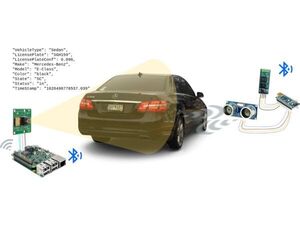
DIY Raspberry Pi ALPR Parking Sys with PlateRecognizer’s SDK
"Learn how to step by step implement your own parking system with the use of a Raspberry Pi, Arduino Nano, and Plate Recognizer's SDK. " [...]

Activewear Suggestion Station
"Understanding the attire for your morning run based on differences in indoor & outdoor heat indexes built on Particle and local weather data The quest to wear the right clothing based on the difference between indoor and outdoor heat indexes when making my morning run is made easier using this Activewear Suggestion station. That is built using a Particle Boron with a grove shield and Open Weather Map “Current Weather Data” API. I attached a DHT 11 sensor to collect indoor temperature/relative humidity and an OLED screen to display indoor and outdoor temperature/relative humidity collected from Open Weather Map. Finally, an RGB LED that changes color based on the difference between the indoor and outdoor heat indexes calculated using our Indoor heat index and outdoor heat index functions. For this project I will be using Particle Workbench that provides all the tools, libraries and extensions you need for IoT development in a single, easy-to-install package. Additionally, by clicking on this link you’ll be taken to the Particle Web IDE that is an Integrated Development Environment; which just so happens to run in your web browser." [...]

Proximity Sensor
"An analogue proximity circuit built with active and passive components Hey there, thanks for coming around, I would love to walk you through on how to create a fully functional proximity sensor and understanding the logic behind it…They are various way to go about it, like using microcontrollers, but I decided to go analogue by building with a few active and passive component. So let’s get to it... In simple terms, A proximity sensor helps you detect a difference in distance from a point or more. The function of the build will be such that the system can both indicate when an obstacle is within proximity and also when it’s out of proximity, and to achieve that we need to get an understanding of some of the components we’re going to work with... 1. LM358 Operational Amplifier 2. Infrared Emitter 3." [...]
Secção Videos
Videos interessantes.
That's all Folks!






